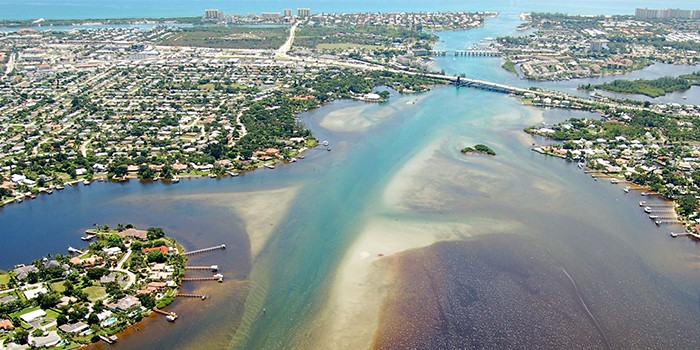Compass Harbourside
- (561) 301-8758
- email us
- Jupiter, Florida, United States


JUPITER, FL – November 3, 2017 – We’ve all seen brown water plums flow out of the Jupiter Inlet and disrupt the azure waters that characterize our beautiful shoreline. Where does this brown water come from? Is it polluted? How can this happen? I have seen all of these sentiments on various social media platforms.
Let’s start with the basics. The Loxahatchee River is a 16-mile-long tidal river that is strongly affected by freshwater pushing downstream and saltwater pushing upstream. Saltwater gains an advantage moving upstream during incoming tide, while freshwater gains an advantage as the tide shifts from high tide to outgoing (or ebb) tide. High tide and low tide are separated by about six hours, with two high tides and two low tides occurring every lunar day (tides are driven by the moon). Thus, near the Jupiter Lighthouse the river appears to alternate between crystal clear blue water and tea-stained brown water every six hours.
We all understand incoming tides push clear, salty Atlantic Ocean water up and into the river, but where does the brown water we see leaving the Jupiter Inlet come from? The Loxahatchee River’s headwaters can be traced to Grassy Waters Preserve (12,800 acres of spectacular old Everglades habitat located south of Northlake Boulevard), the J.W. Corbett Wildlife Management Area (60,348 acres of beautiful habitat located west and south of Beeline Highway), and even Jonathan Dickinson State Park (11,500 acres located west of U.S. Hwy One between Tequesta and Hobe Sound). The water in these freshwater swamps and marshlands is generally clear, but has a characteristic brown color that resembles iced tea. The water is brown not because of pollution, but for the same reason iced tea is brown—tannins (a natural component of plant material) leach from submerged plant material, which stains the water. Thus, the tea-stained water is a characteristic feature of wetlands, even pristine wetlands.
In addition to these large, undeveloped areas that provide clean freshwater that flows to the Loxahatchee River, nearly all drainage ditches, canals, and stormwater systems in between these areas also drain to the Loxahatchee River. During the summer wet season when most rainfall occurs, much of the rainfall runs off the land, flowing through swales and ditches, into the Loxahatchee River, where it ultimately flows out the inlet. More rainfall means more freshwater runoff, which results in more pronounced flows of brown freshwater leaving the inlet and contrasting with the blue Atlantic Ocean waters.
The Loxahatchee River watershed is approximately 240 square miles or 153,600 acres. Please understand if it rains just three inches across the watershed, as it often does in the summer, that can produce over 12.5 billion gallons of freshwater runoff! All of this stormwater must go somewhere, so stormwater systems and canal networks were designed to send stormwater to the ocean.
During the wettest periods, the regional canal (called C-18) drains floodwaters away from developments (think PGA National, Mirasol, Palm Beach Country Estates, Jupiter Farms, etc) and quickly delivers these floodwaters through the S-46 flood control structure and then to the ocean via the Southwest Fork of the Loxahatchee River. The S-46 flood control structure is owned and operated by the South Florida Water Management District (SFWMD). SFWMD only operates the flood control structure on an as needed basis to mitigate flooding within the Loxahatchee River watershed.
So, the next time you see brown water flowing out of Jupiter Inlet, please remind yourself that the Loxahatchee River does not receive freshwater discharges from Lake Okeechobee. The brown water we see at Jupiter Inlet is the price we pay to keep our homes and our neighbors’ homes from flooding.
The Loxahatchee River is a national treasure, and the Loxahatchee River District is dedicated to preserving and protecting the Loxahatchee River through innovative water recycling programs, an award-winning wastewater treatment facility, ongoing river research, and engaging environmental education programs.